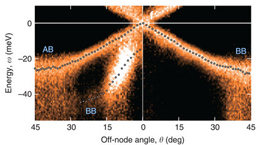Research Abstract
超伝導状態のBi2212におけるノードとアンチノードのギャップと臨界温度の関係
Relation between the nodal and antinodal gap and critical temperature in superconducting Bi2212
2013年5月7日 Nature Communications 4 : 1815 doi: 10.1038/ncomms2805

エネルギー・ギャップは、本来、超伝導を左右する最も有力なパラメーターのはずである。しかし、この考えは高温超伝導体には通用しないものと思われている。なぜなら、d波的な超伝導ギャップが不足ドープとともに異方的に発達するのだが、これを臨界温度Tcに合わせて定式化するのが難しかったからである。今回我々は、Bi2Sr2CaCu2O8+δのノードのギャップのエネルギー2ΔNが、不足ドープとともに 8.5kBTcに沿って密に収束し、さらに、アンチノードのギャップのエネルギーΔ∗と超流動密度の平方根√ρsの積に比例することを、低エネルギー放射光による角度分解光電子分光を用いて示す。定量的な関係から、電子対の凝縮と形成が別れることでノードのギャップとアンチノードのギャップに違いが生じること、および、強結合超伝導状態に特有の位相の不揃いが実在してそれがノードのギャップの抑制をもたらすことが示唆される。これらのギャップに基づく簡潔な関係式は、非従来型のTc決定機構の核心部分を合理的に説明する。
安齋 太陽1*, 井野 明洋2, 有田 将司1, 生天目 博文1, 谷口 雅樹1,2, 石角 元志3**, 藤田 和博4, 石田 茂之3 & 内田 慎一3
- 広島大学放射光科学研究センター
- 広島大学大学院 理学研究科
- 東京大学 理学部 物理学科
- コーネル大学 原子物理学(米国)
*現所属先: 大阪府立大学大学院 工学研究科
**現所属先: 一般財団法人 総合科学研究機構 東海事業センター
An energy gap is, in principle, a dominant parameter in superconductivity. However, this view has been challenged for the case of high-Tc cuprates, because anisotropic evolution of a d-wave-like superconducting gap with underdoping has been difficult to formulate along with a critical temperature Tc. Here we show that a nodal-gap energy 2ΔN closely follows 8.5 kBTc with underdoping and is also proportional to the product of an antinodal gap energy Δ* and a square-root superfluid density √Ps for Bi2Sr2CaCu2O8+δ, using low-energy synchrotron-radiation angle-resolved photoemission. The quantitative relations imply that the distinction between the nodal and antinodal gaps stems from the separation of the condensation and formation of electron pairs, and that the nodal-gap suppression represents the substantial phase incoherence inherent in a strong-coupling superconducting state. These simple gap-based formulae reasonably describe a crucial part of the unconventional mechanism governing Tc.

